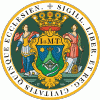Pécs
 |
 |
A city dating back to ancient times, settled by the Celts and the Romans, it was made an episcopal see in early medieval Hungary. It has the oldest university in the country, and is one of its major cultural centers. It has a rich cultural heritage from the age of a 150-year Ottoman occupation. It is historically a multi-ethnic city where many cultures have interacted through 2000 years of history. In recent times, it has been recognized for its cultural heritage, including being named as one of the European Capital of Culture cities.
The earliest name for the territory was its Roman name of Sopianæ. The name possibly comes from the plural of the Celtic sop meaning "marsh". Contrary to the popular belief, the name did not signify a single city, and there are no traces of an encircling wall from the early Roman era, only from the 4th century.
The medieval city was first mentioned in 871 under the name Quinque Basilicae ("five cathedrals".) The name refers to the fact that when constructing the churches of the city, the builders used material from five old Christian chapels. In later Latin documents the city was mentioned as Quinque Ecclesiae ("five churches", a name identical in meaning to the German name Fünfkirchen and the Slovak name Päťkostolie ).
The name Pécs appears in documents in 1235 in the word Pechyut (with modern spelling: pécsi út, meaning "road to/from Pécs") most likely derives from the Proto-Slavic *pęčь or from the Illyrian *penče, both meaning five. In other languages: in Latin, Quinque Ecclesiae; in Italian, Cinquechiese; in Croatian, Pečuh; in Serbian, Печуј (Pečuj); in Slovak, Päťkostolie; in Czech, Pětikostelí; in Dutch, Vijfkerken; in German, Fünfkirchen; and in Turkish, Peçuy.
Map - Pécs
Map
Country - Hungary
 |
 |
| Flag of Hungary | |
The territory of present-day Hungary has for centuries been a crossroads for various peoples, including Celts, Romans, Germanic tribes, Huns, West Slavs and the Avars. The foundation of the Hungarian state was established in the late 9th century AD with the conquest of the Carpathian Basin by Hungarian grand prince Árpád. His great-grandson Stephen I ascended the throne in 1000, converting his realm to a Christian kingdom. By the 12th century, Hungary became a regional power, reaching its cultural and political height in the 15th century. Following the Battle of Mohács in 1526, it was partially occupied by the Ottoman Empire (1541–1699). Hungary came under Habsburg rule at the turn of the 18th century, later joining with the Austrian Empire to form Austria-Hungary, a major power into the early 20th century.
Currency / Language
| ISO | Currency | Symbol | Significant figures |
|---|---|---|---|
| HUF | Hungarian forint | Ft | 2 |
| ISO | Language |
|---|---|
| HU | Hungarian language |















